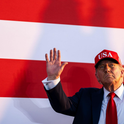If you had read any English language newspaper or website over the past week you could be forgiven for thinking that Sweden was on the cusp of civil war.
Hunting for another round of European populism in response to the refugee crisis, the international press zeroed in on the far-right Sweden Democrats—and built a narrative about a Sweden petrified by immigration and crime.
Sweden’s place as a progressive pin-up means it is its own worst enemy. Whilst people seem quite happy to accept that Britain and the US are dysfunctional and politically chaotic, Sweden is supposed to be a well-ordered paradise—in the same essentialist way that France is supposed to have good food and German trains are supposed to always run on time.
If Sweden isn’t good, then it must be bad—stuck at a crossroads between social democracy and reactionary isolationism.
A mixed picture
The thing about Sweden is that it has never truly been one party’s baby. Not since 1968 has one party had a majority of parliamentary seats.Historically, Sweden has had two electoral blocs comprised of a number of parties: a left-wing group of Socialists, Social Democrats and Greens, and a Liberal-right bloc.
The story does not end there, though—in the past, the Centre party have supported the Social Democrats in government. The alliance between the Liberals and the Centre, with the conservatives in the Moderates and Christian Democrats, is a marriage of convenience.
Though not on the same scale as the Sweden Democrats, Sweden has also seen this kind of politics before. In the early 1990s a populist-right party called New Democracy made a quick entrance and exit to Swedish politics, providing passive support to a conservative government without doing much else.
What really happened on election night
The grand narrative was this election was supposed to be the far right’s, but with all the votes counted, almost 55 per cent of voters opted for a party that is either left or liberal.The Left party, led by the likeable and down-to-earth Jonas Sjöstedt, had their best election result for 20 years and have an enthusiastic and mobilised base. What’s more, they sense that this is not their peak.
Even the Greens, who some thought would be pushed out of parliament, got over the threshold and look set to play an important role in any horse-trading across the parliamentary divide.
The Sweden Democrats underperformed by a good few percentage points, and despite some chest-beating calls for the resignation of the Prime Minister—and overtures to the other conservative parties to form a solidly right-wing government—they are not in a significantly better position than they were four years ago when a cross-party agreement was reached to limit their influence in national politics.
It remains to be seen whether the same will happen again—but the far right are not kingmakers unless the centre wants them to be.
It's the centre—but not as we know it
Meanwhile, what is clear to everyone is that traditional bloc politics will no longer work in Sweden and humility is required from all sides. Over the past twenty years Sweden, like many other countries in Europe, has been characterised by a fragmentation of its political as voters have sought change within their overall bloc.On election night, both the Social Democrats and Liberals gave TV interviews stressing the importance of working across the centre. It is also worth remembering that in Sweden the political centre is still far to the left of Anglo-Saxon countries.
During Sweden’s last term of conservative government, it had higher public spending than New Labour ever achieved—but this kind of nuance rarely makes it onto the front page. Swedish tax data does not attract huge amounts of clicks and page views, but burning cars and looming high rises do.
Malmö, the Swedish city most often portrayed as a site of conflict in the foreign media, is, in reality, a relative success story of post-industrial redevelopment—and a visibly better place for its inhabitants compared to twenty years ago.
Looking ahead
Sweden does have problems that need to be solved: the country has an ongoing chronic housing shortage in its big cities, and economic forecasts show a likelihood of an economic slump in the next year or so.The alienation and economic decline which has driven the Sweden Democrats beyond their strongholds in the south—and into the old industrial towns of the north, and parts of the middle class—will have to be tackled if a new politics is to be born in the coming years.
There is a lot to unpack from this election. Sweden is a huge and varied country that is a lot more complex than people think.
But with the election now over, it seems unlikely the foreign press will stick around long enough to do that complexity justice.












